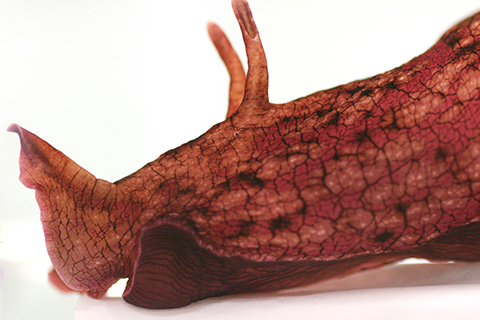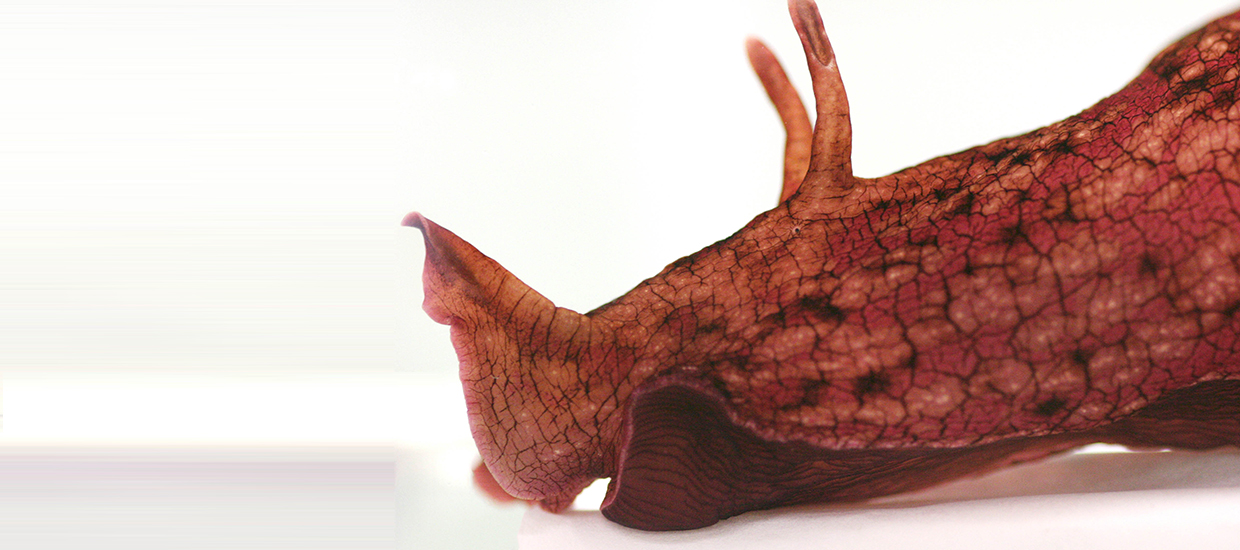Kron, N.S., L.A. Fieber, L. Baker, C. Campbell and M.C. Schmale (2024) Host response to Aplysia Abyssovirus 1 in nervous system and gill. Devel. Comp. Immunol. Vol 159. https://doi.org/10.1016/j.dci.2024.105211
Kron, N.S., B.W. Neuman, S. Kumar, P. Blackwelder, D. Vidal, D. Walker-Phelan, P.D.L. Gibbs, L.A. Fieber, and M.C. Schmale (2024) Expression dynamics of the Aplysia abyssovirus. Virology 589. https://doi.org/10.1016/j.virol.2023.109890
Badal KK, Sadhu A, Raveendra BL, McCracken C, Lozano-Villada S, Shetty AC, Gillette P, Zhao Y, Stommes D, Fieber LA, Schmale MC, Mahurkar A, Hawkins RD, Puthanveettil SV. (2024) Single-neuron analysis of aging-associated changes in learning reveals impairments in transcriptional plasticity. Aging Cell. 2024 Jun 24:e14228. doi: 10.1111/acel.14228.
E.C. Randolph, L.A. Fieber (2023) Improvements in operant memory of Aplysia are correlated with age and specific gene expression. Front Behav Neurosci. 2023; 17: 1221794. https://doi.org/10.3389/fnbeh.2023.1221794
Chaves, G., Ayuyan, A.G., Cherny, V.V., Morgan, D., Franzen, A. Fieber, L.A., Nausch, L., Derst, C., Iryna Mahorivska, I., Jardin, C., DeCoursey, T.E., and B. Musset. 2022. Unexpected expansion of the voltage-gated proton channel family. FEBS J. 290(4):1008-1026.
Kron, N. S. 2022. In search of the Aplysia immunome: an in silico study. BMC genomics 23(1), 1-29
Kron, N.S., and L.A. Fieber. 2021. Aplysia Neurons as a Model of Alzheimer’s Disease: Shared Genes and Differential Expression. J. Molec. Neurosci. 1-16.
Kron, N.S., and L.A. Fieber. 2021. Co-expression analysis identifies neuro-inflammation as driver of sensory neuron aging in Aplysia californica. PLoS ONE 16(6): e0252647.
Kron, N.S., Schmale, M.C., and L.A. Fieber. 2020. Changes in metabolism and proteostasis drive aging phenotype in Aplysia californica sensory neurons. Front. Aging Neurosci, 12:280.
Greer, J.B., Mager, E. M., and L.A. Fieber. 2019. Altered expression of ionotropic L-glutamate receptors in aged sensory neurons of Aplysia californica. PLoS One 14(5): e0217300.
Greer, J.B., Schmale, M.C., and L.A. Fieber. 2018. Whole-transcriptome changes in gene expression accompany aging of sensory neurons in Aplysia californica. BMC Genomics, 19(1):529.
Fieber LA, Kron NS, Greer JB, Rooney H, Prostko RA, Stieglitz JD, Grosell M, Gillette PR. 2018. A comparison of hatchery-rearing in exercise to wild animal physiology and reflex behavior in Aplysia californica. Comp Biochem Physiol A Mol Integr Physiol. 221:24-31.
Greer JB, Khuri S, Fieber LA. 2017. Phylogenetic analysis of ionotropic L-glutamate receptor genes in Bilateria, with special notes on Aplysia californica. BMC Evol Biol. 11(1):11
David, KT. Tanabe P., Fieber LA. 2017. Resource availability drives mating role selection in a simultaneous hermaphrodite Aplysia californica. Bio Bull 231(3):199-206
Kempsell AT., Fieber LA. 2016. Habituation in the tail withdrawal reflex circuit is impaired during aging in Aplysia californica. 2016. Front Aging Neurosci. 8:24
Kempsell AT., Fieber LA. 2015. Age-related deficits in synaptic plasticity rescued by activating PKA or PKC in sensory neurons of Aplysia californica. Front Aging Neurosci. 7:173
Jarvis TA., Capo TR., Bielmyer-Fraser GK. 2015. Dietary metal toxicity to the marine sea hare, Aplysia californica. Comp Biochem Physiol C Toxicol Pharmacol. 174-175:54-64
Kempsell AT., Fieber LA. 2015. Aging in sensory and motor neurons results in learning failure in Aplysia californica. PLoS One 10(5)
Vue Z, Kamel BS, Capo TR, Bardales AT, Medina M. 2014. Comparative analysis of early ontogeny in Bursatella leachii and Aplysia californica. PeerJ.
Kempsell AT., Fieber LA. 2014. Behavioral aging is associated with reduced sensory neuron excitability in Aplysia californica. Front Aging Neurosci. 6:84
Fieber LA., Carlson SL., Kempsell AT, Greer JB, Schmale MC. 2013 Isolation of sensory neurons of Aplysia californica for patch clamp recordings of glutamatergic currents. J Vis Exp. 10:77.
Wang W., Simovic DD, Di M, Fieber L, Rein KS. 2013. Synthesis, receptor binding and activity of iso and azakainoids. Bioorg Med Chem Lett. 23(7):1949-52
Carlson SL, Kempsell AT, Fieber LA. 2012. Pharmacological evidence that D-aspartate activates a current distinct from ionotropic glutamate receptor currents in Aplysia californica. Brain Behav. 2(4):391-401
Carlson SL, Fieber LA. 2012. Unique ionotropic receptors for D-aspartate are a target for serotonin-induced synaptic plasticity in Aplysia californica. Comp Biochem Physiol C Toxicol Pharmacol. 155(1):151-9
Carlson SL, Fieber LA. 2011. Physiological evidence that D-aspartate activates a current distinct from ionotropic glutamate receptor currents in Aplysia californica neurons. J Neurophysiol. 106(4):1629-36.
Fieber LA, Carlson SL, Capo TR, Schmale MC. 2010. Changes in D-aspartate ion currents in the Aplysia nervous system with aging. Brain Res. 1343:28-36
Fiedler TJ, Hudder A, McKay SJ, Shivkumar S, Capo TR, Schmale MC, Walsh PJ. 2010. The transcriptome of the early life history stages of the California sea hare Aplysia californica. Comp Biochem Physiol Part D Genomics Proteomics. 5(2):165-70
Capo TR, Bardales AT, Gillette PR, Lara MR, Schmale MC, Serafy JE. 2009 Larval growth, development, and survival of laboratory-reared Aplysia californica: effects of diet and veliger density. Comp Biochem Physiol C Toxicol Pharmacol. 149(2):215-23.
Ludwig AN, Walsh PJ. 2008. Multiple mating, sperm storage, and mating preference in Aplysia californica. Biol Bull. 215(3):265-71.
Bianchini A, Playle RC, Wood CM, Walsh P.J. 2007, Short-term silver accumulation in tissues of three marine invertebrates: shrimp Penaeus duorarum, sea hare Aplysia californica, and sea urchin Diadema antillarum. Aquat Toxicol. 84(2):182-9.
Gerdes, R., and Fieber, L. A. 2006. Life history and aging of captive-reared California sea hares (Aplysia californica). J. Amer. Assn. Lab. Anim. Sci. 45:40-47.
Irdrisi N., B.F. Barimo, A. Hudder, Capo T.R. and P.J. Walsh. 2006. Rates of Nitrogen Excretion and Oxygen Consumption in the California Sea Hare, Aplysia californica. Bull. Mar. Sci., 79(1): 231-237.
Fieber, L. A., M. C. Schmale, N. Jordi, E. Orbesen, G. A. Diaz and T. R. Capo. 2005. Von Bertalanffy growth models for hatchery-reared A. californica. Bull. Mar. Sci. 76:95-104.
Stommes, D., L A. Fieber, C. Beno, R. Gerdes, and T. R. Capo. 2005. Temperature effects on growth, maturation and lifespan of the California sea hare. Contemp. Topics Lab. An. Sci. 44:31-35.
Medina, M., T. Collins and P.J. Walsh. 2005. Phylogeny of sea hares in the genus Aplysia based on mitochondrial DNA sequence data. Bull. Mar. Sci. 76: 691-698.
Barile P.J, B. E. Lapointe, and T. R. Capo, 2004. Dietary nitrogen availability in macroalgae enhances growth of the sea hare Aplysia californica (Opisthobranchia: Anaspidea). J Exp. Mar. Biol and Ecol. 303:65-78.
Ludwig, A.N. and P.J. Walsh 2004. Sperm storage and use in laboratory-reared Aplysia californica, a simultaneous hermaphrodite. Mar. Biol. 145:727-732.
Capo, T., L. Fieber, D. Stommes, and P. Walsh. 2003. Reproductive output in the hatchery-reared California sea hare at different stocking densities. Contemp. Topics Lab. An. Sci. 42:31-35.
Jaenicke E, Walsh PJ, Decker H. 2003 Isolation and characterization of haemoporin, an abundant haemolymph protein from Aplysia californica. Biochem J. 375:681-688.
Capo, T. R., L. A. Fieber, D. L. Stommes, and P. J. Walsh. 2002. The effect of stocking density on growth rate and maturation time in laboratory-reared California sea hares. Contemp. Topics Lab. An. Sci. 41:18-23.
Medina M, Collins TM, Walsh PJ. 2001. mtDNA ribosomal gene phylogeny of sea hares in the genus Aplysia (Gastropoda, Opisthobranchia, Anaspidea): implications for comparative neurobiology. Syst Biol. 50:676-688.
Capo, T.R. and Walsh, P. 2001. Producing Marine Snails for Biomedical Research. Global Aquaculture Advocate, 4(2):73-74.
Fieber, L. A. 2000. The development of excitatory capability in Aplysia californica bag cells observed in cohorts. Devel. Brain Res. 122:47-58.
Medina, M. and P.J. Walsh. 2000a. Comparison of four mendelian loci of the California sea hare (Aplysia californica) from populations of the Coast of California and the Sea of Cortez. Mar. Biotechnol. 2: 449-455.
Medina, M. and Walsh, P.J. 2000b. Molecular systematics of the order Anaspidea Based on Mitochondrial DNA sequence (12S, 16S and COI). Molecular Phylogenetics and Evolution 15:41-58.
Capo, T., Jaramillo, J., Boyd, A., Lapointe, B., and J. Serafy. 1999. Sustained high yields of Gracilaria(Rhodophyta) grown in intensive large-scale culture. Journal of Applied Phycology 11:143-147.
Fieber, L.A. 1998. Characterization of Na+ and Ca2+ currents in bag cells of sexually immature Aplysia californica. J. Exp. Biol. 201:745-754.
Fieber, L.A. 1995. Characterization and hormonal modulation of Na+ and Ca2+ currents underlying the action potential in bag cells in two species of Aplysia. J. Exp. Biol. 198:2337-2347.
Nolen, T. G., Johnson, P.M., Kicklighter, C., and Capo, T.R. 1995. Ink Secretion by the Marine Snail Aplysia californica Enhances Its Ability to Escape from a Natural Predator. J. Comp Physiol A 176: 239-254





